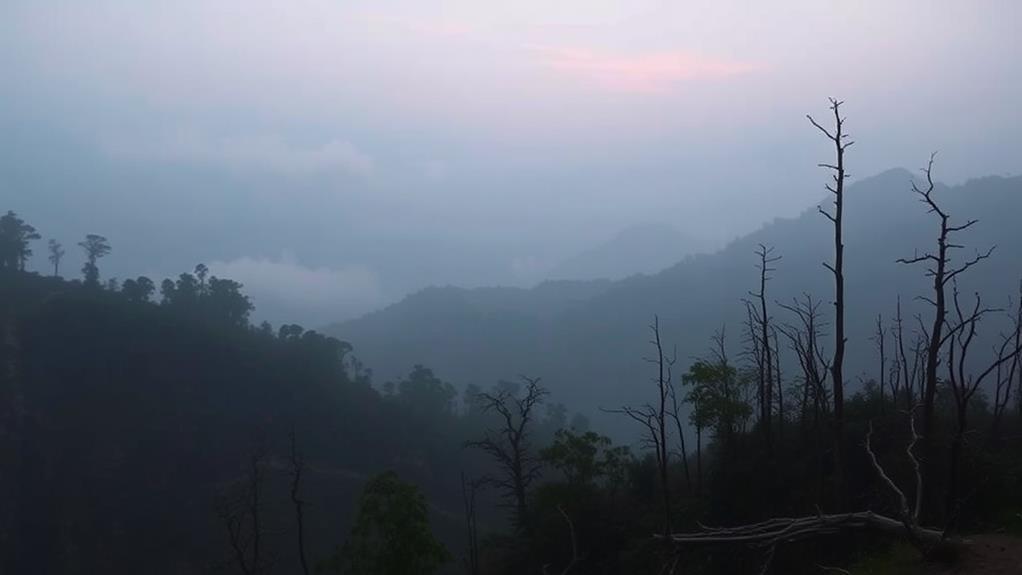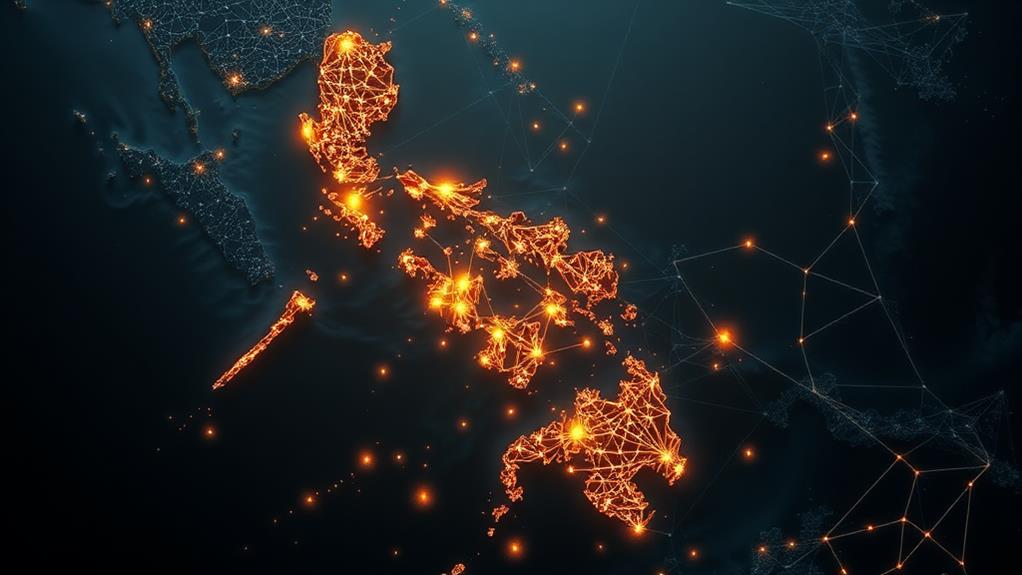The Philippines' landforms and water bodies face unprecedented threats from deforestation, agricultural clearing, and rapid urbanization, which cause soil erosion, landslides, and water scarcity. Nearly 20 million people lack access to safe drinking water, and climate change is projected to decrease rainfall and increase temperatures by 2050. Without immediate action to address these issues, the Philippines’ natural resources and water supply will continue to be increasingly strained. It is imperative that the government and local communities work together to implement sustainable practices for land use and water management in order to ensure a sustainable future for natural resources. This will require not only strict regulations and enforcement, but also education and empowerment of the population to take responsibility for protecting their environment.
To address these challenges, harnessing data for sustainable management is crucial. This involves collecting and analyzing data on land use, water quality, and climate patterns to inform decision-making. For instance, monitoring deforestation rates can help identify areas that require immediate conservation efforts.
Collaborative governance is also essential, involving cooperation among government agencies, local communities, and stakeholders to develop and implement effective conservation strategies. For example, the Department of Environment and Natural Resources can work with local governments to establish protected areas and implement sustainable land-use plans.
Developing climate-resilient infrastructure is critical to mitigating the impacts of climate change. This includes building sea walls to protect coastal communities from rising sea levels and constructing green roofs to reduce urban flooding.
By taking these steps, communities can be empowered to manage their natural resources sustainably, and educational programs can be driven to raise awareness about the importance of conservation.
Ultimately, ensuring indigenous peoples' rights is vital to preserving the Philippines' natural heritage. This involves recognizing their traditional knowledge and practices in managing natural resources and involving them in decision-making processes.
By adopting these strategies, the Philippines can shape a more resilient future for its landforms and water bodies.
Philippine Landforms Under Threat

The Philippines' unique landforms are under threat due to human activities, leading to far-reaching consequences.
Deforestation, driven by logging, mining, and agricultural expansion, has resulted in a forest cover decline of under 25%. This puts 14.1 million hectares of certified alienable land and 15.8 million hectares of forestlands at risk. For instance, the clearing of forests for agricultural purposes has led to soil erosion and landslides, which in turn affect the country's water resources.
Rapid urbanization has converted natural landforms into built environments, increasing vulnerability to environmental hazards. Built-up areas have replaced natural habitats, making cities more prone to flooding and soil erosion. The lack of green spaces and natural barriers has exacerbated the impact of natural disasters.
Coastal landforms are threatened by climate change impacts. Rising sea levels and extreme weather events have accelerated coastal erosion and habitat degradation. For example, the increase in storm surges has damaged coastal ecosystems and affected the livelihoods of communities dependent on them.
Effective management of water resources is crucial to mitigate these impacts. Sustainable practices, such as climate change adaptation strategies, are necessary to protect the country's coastal and marine ecosystems.
Adopting sustainable land use practices is essential to preserve the Philippines' unique landforms as the urban population continues to grow.
Water Security Challenges Ahead
Addressing the Philippines' Water Security Challenges
The Philippines faces a significant water security challenge, with nearly 20 million people lacking access to safe drinking water. This issue is exacerbated by the fact that 80% of water sources are contaminated, leading to thousands of deaths from acute watery diarrhea annually.
Water Security Challenges
| Challenge | Impact |
|---|---|
| Contamination of water sources | Affects 80% of sources |
| Water scarcity in urban areas | Increases risks of shortages due to high demand and pollution |
| Over-reliance on groundwater | Threatens 50% of potable water supply due to over-extraction and contamination |
| Climate change | Decreases rainfall and increases temperatures by 2050, intensifying water security challenges |
Effective Water Management is Crucial
To address these challenges, clean water supply, resource management, and water quality must be prioritized to mitigate water shortages. The country's water management practices need to adapt to the changing climate and population growth. By addressing these water security challenges, the Philippines can ensure a sustainable future for its water resources.
Harnessing Data for Sustainability

Access to Clean Drinking Water in the Philippines
The Philippines faces a significant challenge in providing clean drinking water to its citizens, with over 80% of its water sources contaminated.
Harnessing Data for Sustainability
To address this issue, harnessing data for sustainability is crucial. The PhiGO project is a prime example, utilizing real-time groundwater monitoring through sensor installations in Pampanga Province and Iloilo City. This provides critical data for informed decision-making.
Key Initiatives
Several key initiatives are underway to address the challenge:
Real-time Insights: A dashboard integrated with population and climate metrics offers real-time insights on groundwater quality and quantity, including water levels, pH, salinity, and electrical conductivity.
Smart Water Management: The implementation of smart water management systems and satellite technology enhances the monitoring of water resources, addressing the lack of up-to-date groundwater information.
Low-Cost Water Purification: Development of low-cost water purification technologies and mobile apps for reporting water issues aims to improve community engagement and access to clean water.
Collaborative Governance: Collaborative efforts involving local communities, NGOs, and government initiatives focus on leveraging big data and scientific breakthroughs for effective governance in land and water management.
Collaborative Governance Strategies
Collaborative governance strategies are crucial for effective water resource management. The National Water Resources Management Framework, established in 2018, is a prime example of this approach. It brings together 38 water-related agencies, promoting cooperation and coordination in addressing water security challenges.
Local communities play a vital role in water management initiatives. In the PhiGO project, stakeholder engagement drives data-driven decision-making. Partnerships between government, NGOs, and local stakeholders are essential for implementing the Philippine Water Supply and Sanitation Master Plan, which prioritizes improving water service delivery and promoting sustainable practices.
Collaborative efforts can lead to successful outcomes. The establishment of Marine Protected Area Networks (MPANs) showcases the success of collaborative efforts between local governments and communities in enhancing coastal and marine protection while ensuring sustainable livelihoods.
Capacity-building initiatives empower local leadership and enhance enforcement skills, fostering more resilient governance systems that can adapt to environmental challenges and promote sustainable development in land and water resources.
Climate-Resilient Infrastructure Development

Climate-related disasters in the Philippines frequently damage or destroy water infrastructure, exacerbating water scarcity. To address this, prioritizing climate-resilient infrastructure development is crucial for sustainable water management.
The Philippine government has taken steps towards this goal. The National Water Resources Management Framework, established in 2018, aims to enhance the governance and sustainability of water resources amidst climate challenges. The Philippine Water Supply and Sanitation Master Plan also emphasizes investment in climate-resilient infrastructure to improve water supply systems.
To achieve climate-resilient infrastructure development, four key strategies are essential:
Integrate real-time data monitoring, like the PhiGO project, to assess the impacts of climate change on water resources and infrastructure. This helps identify areas that need improvement.
Foster collaborative partnerships between the government, private sector, and local communities to ensure successful implementation of climate-resilient infrastructure projects. This collaboration is vital for effective project execution.
Invest in local and sustainable infrastructure that addresses the projected water availability deficit of 36,876 MCM/year by 2018, considering future population growth and climate variability. This investment is critical for meeting future water demands.
Align with the Sustainable Development Goals, particularly Goal 6, to ensure that water management practices are environmentally sustainable and socially equitable. This alignment guarantees that water management practices prioritize the well-being of both the environment and society.
Empowering Communities for Change
Empowering Communities for Change in Water Resource Management
Community Engagement and Awareness
Communities can be empowered to drive meaningful change in water resource management and conservation by engaging local populations in community-led initiatives.
The SMARTSeas PH project, for instance, increases awareness and participation in marine conservation, fostering stewardship of marine resources.
Education and Cultural Change
Educational programs on water conservation and hygiene in schools can promote sustainable practices and a culture of environmental stewardship.
These programs can shape children's habits and attitudes towards water conservation, leading to long-term behavioral change.
Indigenous Peoples' Rights
Recognizing the rights of indigenous peoples to ancestral lands is crucial for their involvement in land and water management decisions.
The Indigenous Peoples Rights Act of 1997 emphasizes the importance of indigenous peoples' participation in decision-making processes.
Community-Led Water Management
Involving local communities in monitoring water quality and availability ensures their voices and needs are considered in resource management strategies.
This approach guarantees sufficient water for local communities and promotes accountability in water management.
Collaborative Efforts
Collaborative efforts between government, NGOs, and local stakeholders are essential for enhancing water service delivery and promoting sustainable practices.
Examples include implementing rainwater harvesting systems in rural areas, which reduce the strain on local water resources.
How Can Conservation and Sustainable Development Practices Be Applied to the Exploration of the Benham Rise?
Conservation and sustainable development practices can be applied to exploring the benham rise by conducting thorough environmental impact assessments before any exploration activities. Additionally, implementing strict regulations on fishing, mining, and other commercial activities can help ensure that the natural resources of exploring the Benham Rise are preserved for future generations.
How Can Visiting Manila’s Museums and Historical Sites Promote Awareness for Conservation of Philippine Landforms and Water Bodies?
Visiting Manila historical sites serves as a gateway to understanding the Philippines’ rich heritage and natural beauty. By exploring museums and landmarks, visitors gain deeper insights into the environment’s significance. This awareness fosters a stronger connection to protecting the nation’s landforms and water bodies for future generations.
Foresight and Futures Literacy

Foresight and Futures Literacy are Essential for Sustainable Land and Water Governance
Visionary approaches to land and water governance are crucial in navigating the complexities of sustainable development. As a key stakeholder, you play a vital role in shaping the future of the Philippines' landforms and water bodies. To address the challenges of sustainable development, understanding the importance of foresight and futures literacy is vital.
Futures Literacy Can Enhance Land Use Planning
Incorporating futures thinking into land use planning allows for more effective strategies that balance human needs with environmental sustainability.
For instance, anticipating population growth and urbanization can help identify areas for sustainable development and conservation.
Futures Literacy Can Protect Coastal Resources
Futures literacy can help anticipate and mitigate the impacts of climate change on coastal ecosystems, ensuring the long-term health of these vital resources.
By considering scenario-based planning, you can develop adaptive management strategies for coastal ecosystems.
Futures Literacy Can Inform Urban Planning
Considering diverse scenarios and worldviews enables the design of more resilient and sustainable urban spaces that prioritize the well-being of both humans and the environment.
For example, incorporating green infrastructure into urban planning can mitigate the urban heat island effect and reduce flood risk.
Futures Literacy Can Strengthen Protected Areas Management
Futures literacy can facilitate more effective management of protected areas, ensuring the conservation of biodiversity and ecosystem services for future generations.
By anticipating future threats and opportunities, you can develop proactive strategies for protected areas management.
Frequently Asked Questions
What Are the Problems With Water Conservation in the Philippines?
Water Conservation Challenges in the Philippines
Contamination and Pollution: Water pollution from contaminated sources affects nearly 20 million people in the Philippines. For instance, agricultural runoff from farms and industrial waste from factories contaminate water sources, making them unsafe for human consumption.
Over-Extraction and Depletion: The Philippines faces over-extraction issues, which deplete groundwater supplies. This is particularly problematic in areas where groundwater is the primary source of water for drinking, agriculture, and industry.
Infrastructure Challenges: Outdated supply systems and inadequate infrastructure exacerbate the water conservation problem. For example, old pipes and inadequate storage facilities lead to water loss and waste.
Climate Change Impacts: Decreased rainfall and increased temperatures due to climate change further strain the country's water resources. This leads to droughts, affecting agriculture and urban water supply.
Rapid Population Growth and Demand: The Philippines' rapid population growth intensifies demand for water, putting additional pressure on already strained resources.
To address these issues, prioritizing sustainable water management practices is crucial to ensure a secure and clean water supply for the future.
What Is the Current Situation of Water Resources in the Philippines?
Water scarcity is a critical issue in the Philippines. The country faces a severe water crisis, with nearly 20 million people lacking access to safe drinking water. This is because 80% of water sources are contaminated, making it difficult for people to access clean water.
Pollution is a significant contributor to the water crisis. Agricultural runoff and industrial waste are two primary sources of pollution that strain the country's water resources. For instance, the use of pesticides and fertilizers in farming can contaminate water sources, while industrial activities can release toxic chemicals into the environment.
Climate change is exacerbating the water crisis. Rising temperatures and decreasing rainfall, projected to occur by 2050, disrupt the ecosystem balance.
This makes it essential to adopt traditional practices and implement government policies to address the crisis.
How to Conserve and Protect Water Resources in the Philippines?
Conserve Water Resources with Rainwater Harvesting
Implementing rainwater harvesting systems is an effective way to reduce the demand on potable water sources in the Philippines. Households and buildings can collect and store rainwater for non-potable uses like flushing toilets and washing clothes.
Educate Communities on Sustainable Practices
Educating communities on sustainable practices is crucial to changing behaviors and promoting water conservation.
Proper hygiene practices, such as taking shorter showers and fixing leaks, can significantly reduce water waste. Additionally, promoting water-saving appliances and devices can also contribute to water conservation.
Promote Sustainable Agriculture Methods
Sustainable agriculture methods can minimize chemical runoff, which can pollute water sources.
Using organic fertilizers and pesticides can reduce the amount of chemicals that enter waterways. Furthermore, implementing crop rotation and mulching can also reduce soil erosion and prevent sedimentation in water sources.
Enforce Pollution Control Measures and Restore Ecosystems
Enforcing pollution control measures and restoring degraded ecosystems are essential to maintaining water quality.
Regular monitoring and inspection of industrial and agricultural activities can help prevent pollution. Additionally, restoring degraded ecosystems like watersheds and forests can help maintain water quality by filtering out pollutants and sediments.
What Are the Reasons That Led to the Land Conflict in the Philippines?
Land conflict in the Philippines stems from various factors.
One primary driver is unequal land ownership, where a significant 89% of farm holdings are under 3 hectares. This means that a small portion of land is owned by a few individuals, leaving many farmers with limited land to cultivate.
Another factor is the inadequate recognition of indigenous rights. The government often fails to obtain Free Prior and Informed Consent from indigenous communities before granting concessions in their ancestral domains. This lack of consent leads to conflicts between the government and indigenous peoples.
Agricultural expansion, urban development, and mining operations also contribute to land conflicts. As these activities expand, they often encroach on ancestral lands, displacing indigenous communities and sparking conflicts.
Furthermore, weak environmental policies and poor land registration processes exacerbate the situation. Without clear policies and registration processes, land ownership and usage become unclear, leading to disputes and conflicts.